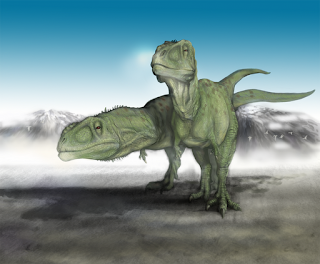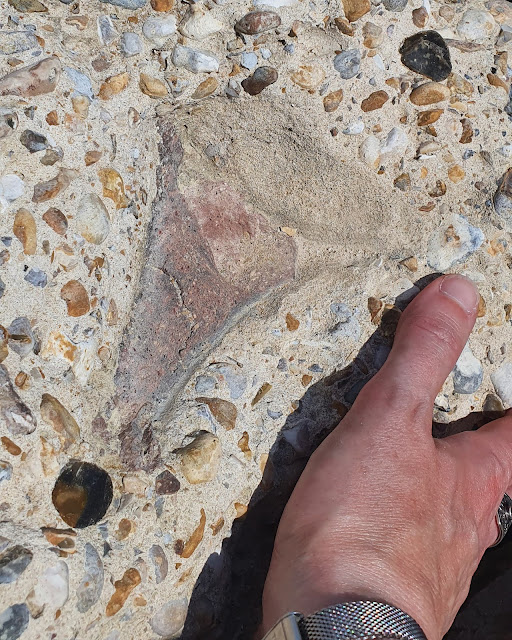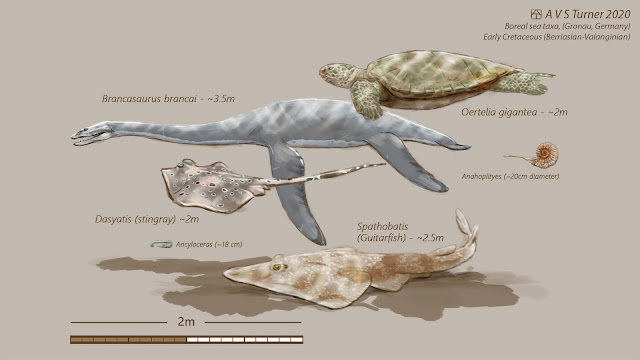Giganotosaurus Carolinii
Apologies for this one, as I’m afraid I must keep it brief. We just moved house this week and have yet to get an internet connection set up, so I’m having to make this entry at home, transfer it to my phone, then email it to myself and finish the whole thing off after hours at work! So, with out further ado, I give you…
Giganotosaurus Carolinii
Sauriscia: Therapoda: Tetanurae
Late Cretaceous (Albian - Cenomanian), 112 mya – 94 mya
Neuquén Province, Argentina
Giganotosaurus rightly got a lot of attention after it was first discovered in Patagonia in the mid ‘90s, but has in recent years drifted further from the public imagination. This may be because Giganotosaurus missed out on the role as ‘next biggest thing’ in the third ‘Jurassic Park’ film, (which went to Spinosaurus Egypticus, perhaps because the film makers felt it would be sensible to pit a Tyrannosaurus rex against something that doesn’t look too much like a T. rex?) or perhaps because gigantism as ceased to be a feature in the more interesting dinosaur finds of the past ten years or so. The most interesting new discoveries (most notably from China) have tended to be smaller species, with precision-engineered feathers, and preserved pigmentation rather than the vast and awe-inspiring (though ultimately quite recognisable) types.
Although the popular imagination is no longer so enthralled by the biggest species, I still feel that Giganotosaurus carolinii deserves a shout. Its cultural significance at the time it was first described was undeniable: finally someone had found a carnivorous dinosaur larger than a Tyrannosaurus (everyone loves a T. rex, but let’s be honest: we were all getting just a little bit bored)! Furthermore, evidence indicated that these new southern cousins were far more interesting animals – although greater in length, they were of a lighter build, clearly more agile; they appeared also to have lived in family groups, hunting as a team (evidenced by finds of several individuals fossilized together, with ages ranging from very young to clearly senior. The lack of other species’ remains along with the nature of the rock the Giganotosaurs were encased in indicated that the animals did not die in a flash-flood, as has been suggested). All this meant that they could conceivably have hunted the biggest of big game – the titanic Argentinosaurs and magnificent Andesaurus: the kind of spectacle unimaginable, even for a large Tyrannosaurid.
I’ve wanted to restore Giganotosaurus for its scientific and cultural significance, but then there’s the just-plain beauty of the Carcharadontosaurid family (to which Giganotosaurus belongs). Their long, sloping skulls and pronounced mandibles are a feature I find just irresistible. They’re a sheer pleasure to draw. This representation is an image I actually began over three years ago and abandoned halfway through (I was going through a difficult time with a bad relationship and was failing to see much point in pursuing palaeoart, or any kind of pleasure for that matter). I found it as I was sifting through my slush-pile on the hard drive the other day and thought ”why did I ever give up on those guys? It’s not a bad image at all!”. So I spent a couple of days scrubbing them up and this is the result: Two young male Giganotosaurs taking a walk on a crisp, cold morning, across a volcanic plateau. They’re not searching for food – they’ve reached an age where they’ve had to leave their pride and strike out on their own. They aren’t quite fully grown yet, so they’ll maybe spend up to three years wandering, taking smaller prey until they find a new pride to settle with. Their colouration is dappled to give them maximum camouflage, but as every individual’s pattern of brown spots is unique, they can also use this for identification within a group (not in any way based on scientific evidence – I just thought it would be a nice touch!)



Comments
Post a Comment